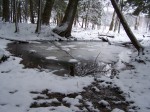Where Science, Art and Nature Come Together.
S is for Spring… and Salamanders!
The prediction for this weekend is warm temperatures in the 50’s. It won’t be long before the vernal pools on our Lillibridge property swell with runoff from the old-growth forest and prepare to host a wide variety of salamanders for their annual mating ritual. A warm rainy night with temperatures about 45 degrees can trigger a mass migration of salamanders to the pools.
Vernal pools are fascinating ecosystems. The pools are created in our old-growth forest when large trees fall and the area displaced by the root section creates a natural depression. The depression fills with rain and snow melt creating these temporary (ephemeral) pools. These pools may dry up later in the year and consequently do not support fish and/or turtles, which are natural predators of salamanders. The pools are an ideal spot for salamanders to breed and occasionally support fairy shrimp, an important foodstuff of juvenile salamanders.
Vernal pools, being wet, also can host breeding mosquitoes. Consequently, over the years they have been the target of insect control efforts, being filled in or sprayed with insecticide as preventative measures to address the mosquito issue. Unfortunately this has resulted in the loss of valuable habitat for amphibians. Today, people are more aware of the importance of vernal pools. In the New England states there is a significant citizen science movement to identify, preserve, and monitor vernal pools. Locally, forest owners have been educated and encouraged to create man-made pools to increase biodiversity and create critical habitat for amphibians.
We are fortunate that the vernal pools on our Lillibridge property are naturally occurring and undisturbed. The property is host to an incredible 12 of 18 native salamander species. Each spring we anticipate the “big walk”, the night of the mass migration. The pool immediately behind the kiosk at Lillibridge has had Red-Spotted Newts, Spotted Salamanders, and Jefferson Salamanders. The later two are species of special concern in New York State.
The males and females arrive together at the pool of their birth, court, mate, and then deposit masses of eggs in the pool. In approximately six weeks, the eggs will hatch and the larvae will feed on aquatic invertebrates in the pool until they mature and leave the pool in summer, just about the time the pools dry up.
You can observe the salamanders in the pool and watch changes in the eggs. It is important not to disturb anything in or around the pool while this process occurs. In fact, look carefully where you step. It’s not uncommon to see salamanders en route to or from the pool visible on the forest floor and trail path. You may also spot tracks of raccoons, opossums, shrews, and other predators that feed on the salamanders.
Other amphibians identified on the Lillibridge property include: American Toad, Spring Peeper, Wood Frog, Green Frog, Gray Tree Frog, Red-Spotted Newt (aka Red Eft), Spotted Salamander, Jefferson Salamander, Northern Dusky Salamander, Mountain Dusky Salamander, Wehrle’s Salamander, Northern Slimy Salamander, Redback Salamander, Northern Two-Lined Salamander, Northern Red Salamander, Four-Toed Salamander, and Long-Tailed Salamander.
Visitors can explore the amphibians of Lillibridge in our annual program Awesome Amphibians, September 21, 2013 with volunteer naturalist Bill Shelp.
Roger Tory Peterson Institute will be offering a program on Vernal Pools March 14, 2013. Presented by their new executive director, Dr. Twan Leenders, a noted conservation biologist and researcher on amphibians, this should be a great presentation to expand your understanding of these important habitats. For details click here.


